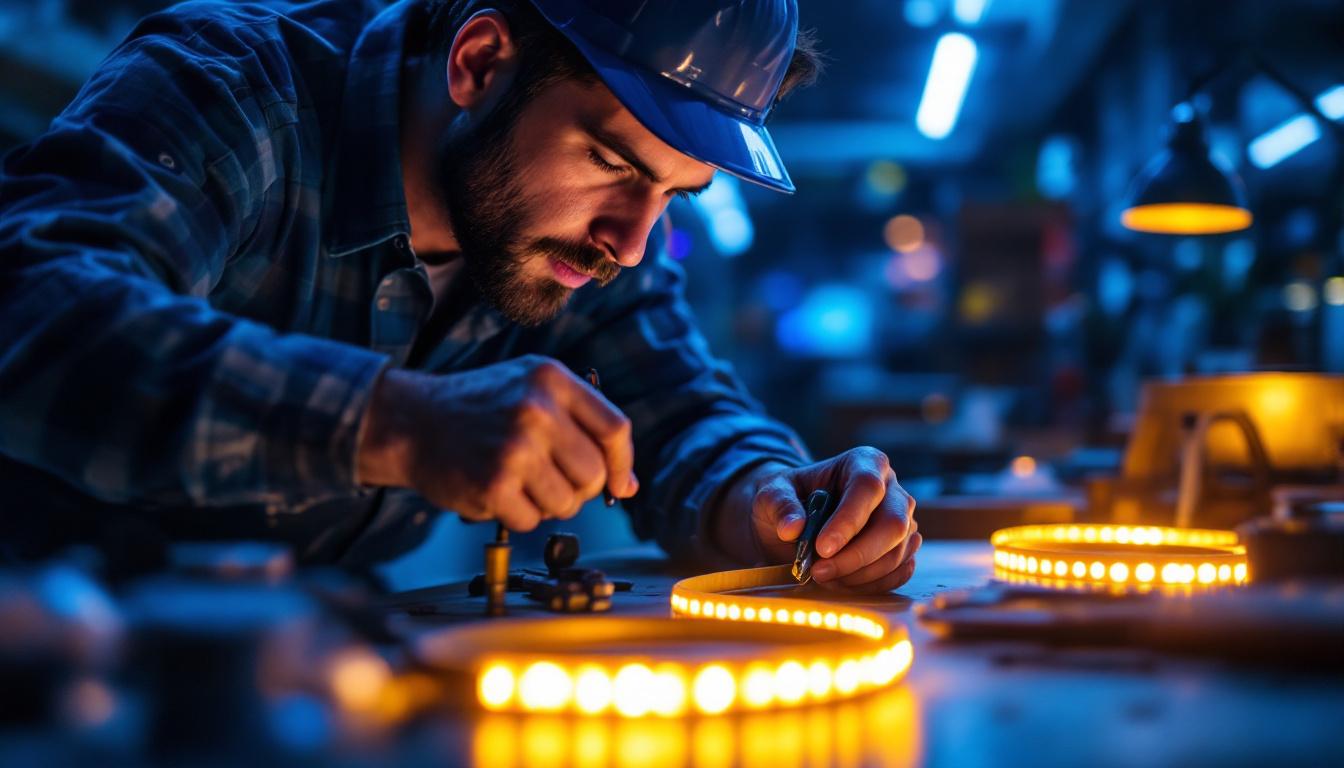
In the world of modern lighting, LED tape lights have emerged as a versatile and efficient solution for various applications. For lighting contractors, mastering the use of LED tape light connectors is essential for delivering high-quality installations that meet client expectations. This article delves into the intricacies of LED tape light connectors, offering insights and tips to help contractors excel in their projects.
LED tape lights, also known as LED strip lights, are flexible circuit boards populated with light-emitting diodes (LEDs). They are available in various colors, brightness levels, and lengths, making them suitable for a wide range of applications, from accent lighting to full-scale illumination. The versatility of LED tape lights allows them to be used in both residential and commercial settings, enhancing the ambiance of spaces such as kitchens, living rooms, and retail stores.
These lights are particularly favored for their low energy consumption, long lifespan, and ease of installation. With advancements in technology, modern LED tape lights can last up to 50,000 hours, significantly reducing the need for frequent replacements. However, the effectiveness of LED tape lights largely depends on the connectors used to join different sections or connect to power sources, which can affect both the performance and aesthetic of the lighting design.
When it comes to LED tape light connectors, there are several types to consider, each with its own advantages and applications. Understanding these types is crucial for any lighting contractor looking to provide optimal solutions for their clients. The right connector not only ensures a seamless connection but also contributes to the overall safety and efficiency of the lighting system.
Selecting the appropriate connector for a specific project can significantly impact the overall success of the installation. Factors to consider include the type of LED tape being used, the installation environment, and the desired longevity of the connection. Additionally, understanding the electrical specifications, such as voltage and wattage, is essential to ensure compatibility and prevent potential issues.
For instance, in high-traffic areas or places prone to moisture, a more robust connector may be necessary to ensure durability. In such cases, waterproof connectors can provide an added layer of protection against environmental factors. Conversely, for temporary setups or less demanding environments, simpler connectors may suffice, allowing for easy removal and reconfiguration. Furthermore, considering the aesthetic aspect of the connectors is important, as they should blend seamlessly with the overall design of the space, maintaining a clean and polished look.
Proper installation techniques are vital for ensuring that LED tape lights function effectively and safely. Lighting contractors should follow best practices to avoid common pitfalls that can lead to performance issues or even safety hazards.
Before connecting LED tape lights, it is essential to prepare the tape properly. This involves cutting the tape at designated points, ensuring that the cut is straight and clean. Many LED tapes have marked cut lines to guide contractors in making precise cuts.
Additionally, it is crucial to remove any adhesive backing from the cut ends if using solderless connectors. This ensures a secure fit and optimal electrical contact. Taking the time to prepare the tape correctly will not only enhance the longevity of the installation but also improve the overall aesthetic appeal of the lighting setup.
Moreover, it is advisable to inspect the LED tape for any visible damage or defects before installation. Look for any signs of fraying, discoloration, or damaged circuit traces, as these can affect performance. Ensuring that the tape is in perfect condition will help avoid unnecessary troubleshooting later on.
Once the tape is prepared, the next step is to connect the tape lights using the chosen connectors. For connector clips, simply align the tape with the clip and press down firmly. For solderless connectors, follow the manufacturer’s instructions to ensure a secure fit.
When using wire connectors, it is important to strip the ends of the wires appropriately and connect them securely to the power source. Always double-check connections to avoid any potential short circuits. A good practice is to use a multimeter to test the connections before finalizing the installation, ensuring that the voltage is correct and that there are no unexpected interruptions in the circuit.
Furthermore, consider the layout and design of the installation. Planning the route of the LED tape lights can help in achieving a seamless look while also ensuring that the connectors are not placed in visible or awkward positions. This attention to detail not only enhances the visual appeal but also contributes to the overall functionality of the lighting system, allowing for even light distribution and minimizing shadows.
Even with the best preparation, lighting contractors may encounter challenges during the installation of LED tape light connectors. Understanding these common issues and their solutions can help streamline the process and enhance overall project success.
One of the most common problems contractors face is connectivity issues. Poor connections can lead to flickering lights or sections of the tape not lighting up at all. To mitigate this, ensure that all connections are secure and that the tape is free from dust or debris that could interfere with electrical contact.
If a section of the tape is not functioning, it may be necessary to test each connection point individually to identify the source of the problem. This methodical approach can save time and frustration during installations. Additionally, using a multimeter to check the voltage at various points can provide insights into where the connectivity issue lies, allowing for a more targeted and efficient troubleshooting process.
LEDs generate heat, and improper heat management can lead to reduced lifespan and performance. Contractors should ensure that the tape lights are installed in a manner that allows for adequate ventilation. Using heat sinks or aluminum channels can help dissipate heat effectively.
Additionally, it is important to avoid overloading the tape lights by exceeding the recommended wattage. This not only prolongs the life of the LEDs but also enhances safety in the installation. Furthermore, considering the ambient temperature of the installation environment is crucial; in areas with higher temperatures, additional cooling solutions may be necessary to maintain optimal performance. Regular maintenance checks can also help identify any potential heat-related issues before they escalate, ensuring that the lighting system remains efficient and reliable over time.
Once the installation is complete, maintenance becomes a key consideration for lighting contractors. Regular maintenance can extend the life of LED tape lights and ensure optimal performance over time. By implementing a structured maintenance schedule, contractors can help clients avoid unexpected failures and costly replacements, ultimately fostering a reliable and efficient lighting environment.
Conducting regular inspections of LED tape light installations is essential. Look for signs of wear, such as frayed wires or loose connections, and address any issues promptly. This proactive approach can prevent larger problems down the line. Inspections should ideally be performed every few months, or more frequently in environments that are prone to dust or moisture, as these factors can significantly impact the longevity of the connectors.
Additionally, checking for dust buildup on the tape lights and connectors can help maintain brightness and efficiency. A simple wipe down with a soft cloth can make a significant difference. Moreover, it is advisable to inspect the power supply units, as fluctuations in voltage can affect the performance of the entire lighting system. Ensuring that all components are functioning optimally will not only enhance the aesthetic appeal but also improve energy efficiency, leading to lower utility bills for clients.
As technology advances, new components and connectors may become available that offer improved performance or energy efficiency. Staying informed about the latest developments in LED technology can provide contractors with opportunities to upgrade existing installations. For instance, newer connectors may feature enhanced waterproofing or better heat dissipation, which can be particularly beneficial in outdoor or high-temperature settings.
Offering clients the option to upgrade their systems can enhance their satisfaction and potentially lead to additional business opportunities for contractors. Furthermore, educating clients about the benefits of these upgrades—such as increased brightness, longer lifespan, and lower energy consumption—can empower them to make informed decisions. This not only solidifies the contractor’s reputation as a knowledgeable professional but also fosters a long-term relationship built on trust and expertise. By keeping abreast of industry trends and innovations, contractors can position themselves as leaders in the field, ready to meet the evolving needs of their clients.
Mastering LED tape light connectors is a vital skill for lighting contractors looking to deliver exceptional results in their projects. By understanding the types of connectors available, employing proper installation techniques, and addressing common challenges, contractors can ensure that their installations are both functional and aesthetically pleasing.
Moreover, prioritizing maintenance and staying updated on advancements in LED technology will further enhance the quality of work provided. As the demand for LED tape lights continues to grow, those who master the art of connecting and maintaining these lights will undoubtedly stand out in the competitive landscape of lighting design and installation.
Ready to elevate your lighting projects with the finest LED tape light connectors? Look no further than LumenWholesale, where we offer an exceptional range of spec-grade lighting products at wholesale prices that can’t be beaten. Say goodbye to local distributor markups and hello to high-quality, reliable lighting that meets the highest industry standards. With our commitment to affordability and convenience, you’ll enjoy free shipping on bulk orders, ensuring you get the best value without any hidden fees. Make your next project shine by choosing Wholesale Lighting at the Best Value with LumenWholesale.

Discover the essential strategies and insights lighting contractors need to excel in their field.

Discover effective strategies for training your team in using grow lights within a greenhouse setting.

Discover the essential facts about automatic outdoor light timers in this comprehensive guide tailored for lighting contractors.

Discover essential insights into the lifespan of fluorescent bulbs and learn strategies to enhance efficiency and client satisfaction.